HND in Hospitality: Food Safety Management Report - Unit 31 Analysis
VerifiedAdded on 2020/10/23
|12
|3429
|405
Report
AI Summary
This report provides a detailed analysis of food safety management within the hospitality industry, using Hilton Hotel and Prezzo Restaurant as case studies. It addresses critical aspects such as controlling physical and chemical contamination, comparing food poisoning and food-borne infections, and outlining effective food spoilage agents. The report delves into various methods of food preservation, evaluates temperature control systems, and emphasizes the significance of safe food storage. It highlights the importance of personal hygiene, cleaning and disinfection processes, and pest control in food premises. Furthermore, the report discusses the necessity of hygiene design and construction in food premises, alongside the role of training as a quality assurance mechanism. It concludes with a review of food hazard risk assessment, the implementation of food safety control systems, and compliance with food safety legislation, offering a comprehensive overview of food safety practices and challenges.
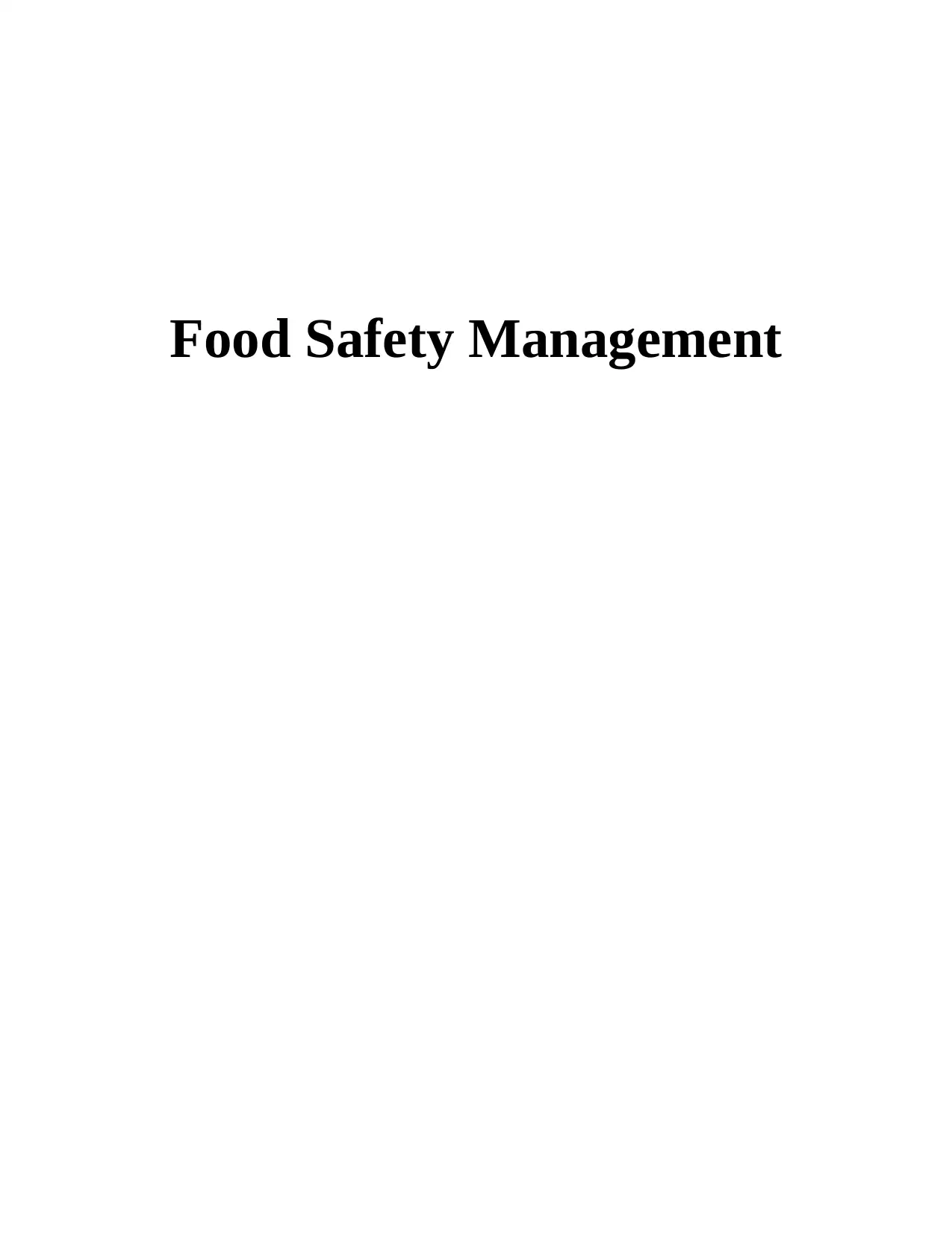
Food Safety Management
Paraphrase This Document
Need a fresh take? Get an instant paraphrase of this document with our AI Paraphraser
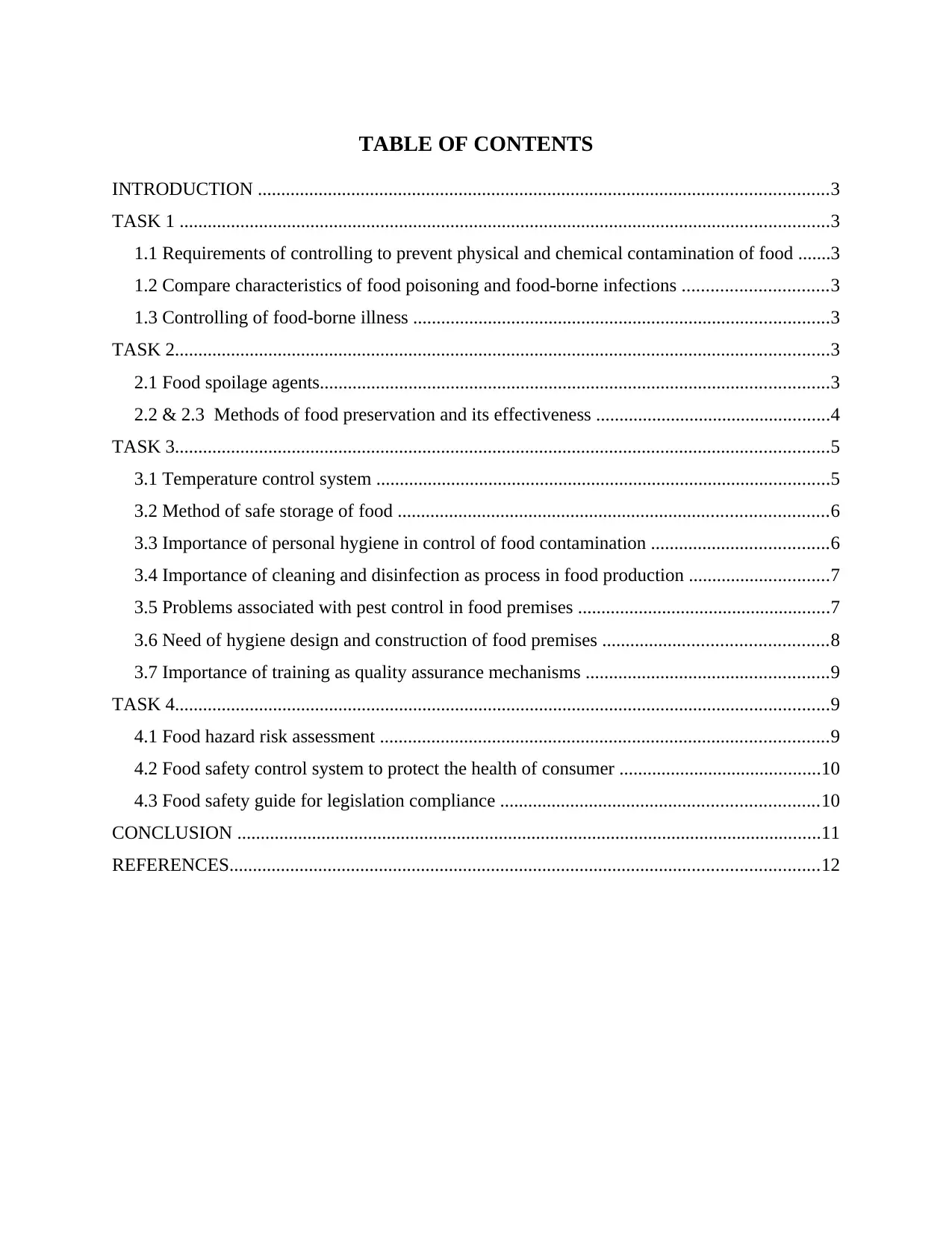
TABLE OF CONTENTS
INTRODUCTION ..........................................................................................................................3
TASK 1 ...........................................................................................................................................3
1.1 Requirements of controlling to prevent physical and chemical contamination of food .......3
1.2 Compare characteristics of food poisoning and food-borne infections ...............................3
1.3 Controlling of food-borne illness .........................................................................................3
TASK 2............................................................................................................................................3
2.1 Food spoilage agents.............................................................................................................3
2.2 & 2.3 Methods of food preservation and its effectiveness ..................................................4
TASK 3............................................................................................................................................5
3.1 Temperature control system .................................................................................................5
3.2 Method of safe storage of food ............................................................................................6
3.3 Importance of personal hygiene in control of food contamination ......................................6
3.4 Importance of cleaning and disinfection as process in food production ..............................7
3.5 Problems associated with pest control in food premises ......................................................7
3.6 Need of hygiene design and construction of food premises ................................................8
3.7 Importance of training as quality assurance mechanisms ....................................................9
TASK 4............................................................................................................................................9
4.1 Food hazard risk assessment ................................................................................................9
4.2 Food safety control system to protect the health of consumer ...........................................10
4.3 Food safety guide for legislation compliance ....................................................................10
CONCLUSION .............................................................................................................................11
REFERENCES..............................................................................................................................12
INTRODUCTION ..........................................................................................................................3
TASK 1 ...........................................................................................................................................3
1.1 Requirements of controlling to prevent physical and chemical contamination of food .......3
1.2 Compare characteristics of food poisoning and food-borne infections ...............................3
1.3 Controlling of food-borne illness .........................................................................................3
TASK 2............................................................................................................................................3
2.1 Food spoilage agents.............................................................................................................3
2.2 & 2.3 Methods of food preservation and its effectiveness ..................................................4
TASK 3............................................................................................................................................5
3.1 Temperature control system .................................................................................................5
3.2 Method of safe storage of food ............................................................................................6
3.3 Importance of personal hygiene in control of food contamination ......................................6
3.4 Importance of cleaning and disinfection as process in food production ..............................7
3.5 Problems associated with pest control in food premises ......................................................7
3.6 Need of hygiene design and construction of food premises ................................................8
3.7 Importance of training as quality assurance mechanisms ....................................................9
TASK 4............................................................................................................................................9
4.1 Food hazard risk assessment ................................................................................................9
4.2 Food safety control system to protect the health of consumer ...........................................10
4.3 Food safety guide for legislation compliance ....................................................................10
CONCLUSION .............................................................................................................................11
REFERENCES..............................................................................................................................12

INTRODUCTION
Food safety and hygiene becomes an emerging demand in the food industry which is
universal concern. Food safety is knowledge based discipline describing handling, preparation
and storage of food in effective manner that prevent food-borne illness. This study is based on
Hilton hotel and resort as well as Prezzo restaurant. Hilton is the international brand of full of
services hotel and resort. Prezzo is British owned chain of restaurants serving food inspired in
the UK. Report will explain requirements of controlling to prevent physical and chemical
contamination of food. It will compare the characteristics of food poisoning and food-borne
infection.
TASK 1
1.1 Requirements of controlling to prevent physical and chemical contamination of food
COVERED IN PPT
1.2 Compare characteristics of food poisoning and food-borne infections
COVERED IN PPT
1.3 Controlling of food-borne illness
COVERED IN PPT
TASK 2
2.1 Food spoilage agents
Food Spoilage:
It can be determined as irritating change in normal state of food. Changes involves smell,
taste, touch or sight. Spoilage is the procedure in which food drop to point that is not killable and
reduce its quality (Gu and et.al., 2019). Food is capable of spoiling is referred to as perishable
food. Due the number of reasons, these modifications are air and oxygen, moisture, light,
temperature, microbial growth etc. There are many agents of food spoilage like bacteria, yeast,
mould, temperature and chemical reaction.
Agents Affects of food
Bacteria Bacteria break down food, acids and waste products
are made in the process.
Yeasts It can be responsible for decomposition of food
with high sugar content. This effect in production
Food safety and hygiene becomes an emerging demand in the food industry which is
universal concern. Food safety is knowledge based discipline describing handling, preparation
and storage of food in effective manner that prevent food-borne illness. This study is based on
Hilton hotel and resort as well as Prezzo restaurant. Hilton is the international brand of full of
services hotel and resort. Prezzo is British owned chain of restaurants serving food inspired in
the UK. Report will explain requirements of controlling to prevent physical and chemical
contamination of food. It will compare the characteristics of food poisoning and food-borne
infection.
TASK 1
1.1 Requirements of controlling to prevent physical and chemical contamination of food
COVERED IN PPT
1.2 Compare characteristics of food poisoning and food-borne infections
COVERED IN PPT
1.3 Controlling of food-borne illness
COVERED IN PPT
TASK 2
2.1 Food spoilage agents
Food Spoilage:
It can be determined as irritating change in normal state of food. Changes involves smell,
taste, touch or sight. Spoilage is the procedure in which food drop to point that is not killable and
reduce its quality (Gu and et.al., 2019). Food is capable of spoiling is referred to as perishable
food. Due the number of reasons, these modifications are air and oxygen, moisture, light,
temperature, microbial growth etc. There are many agents of food spoilage like bacteria, yeast,
mould, temperature and chemical reaction.
Agents Affects of food
Bacteria Bacteria break down food, acids and waste products
are made in the process.
Yeasts It can be responsible for decomposition of food
with high sugar content. This effect in production
⊘ This is a preview!⊘
Do you want full access?
Subscribe today to unlock all pages.

Trusted by 1+ million students worldwide
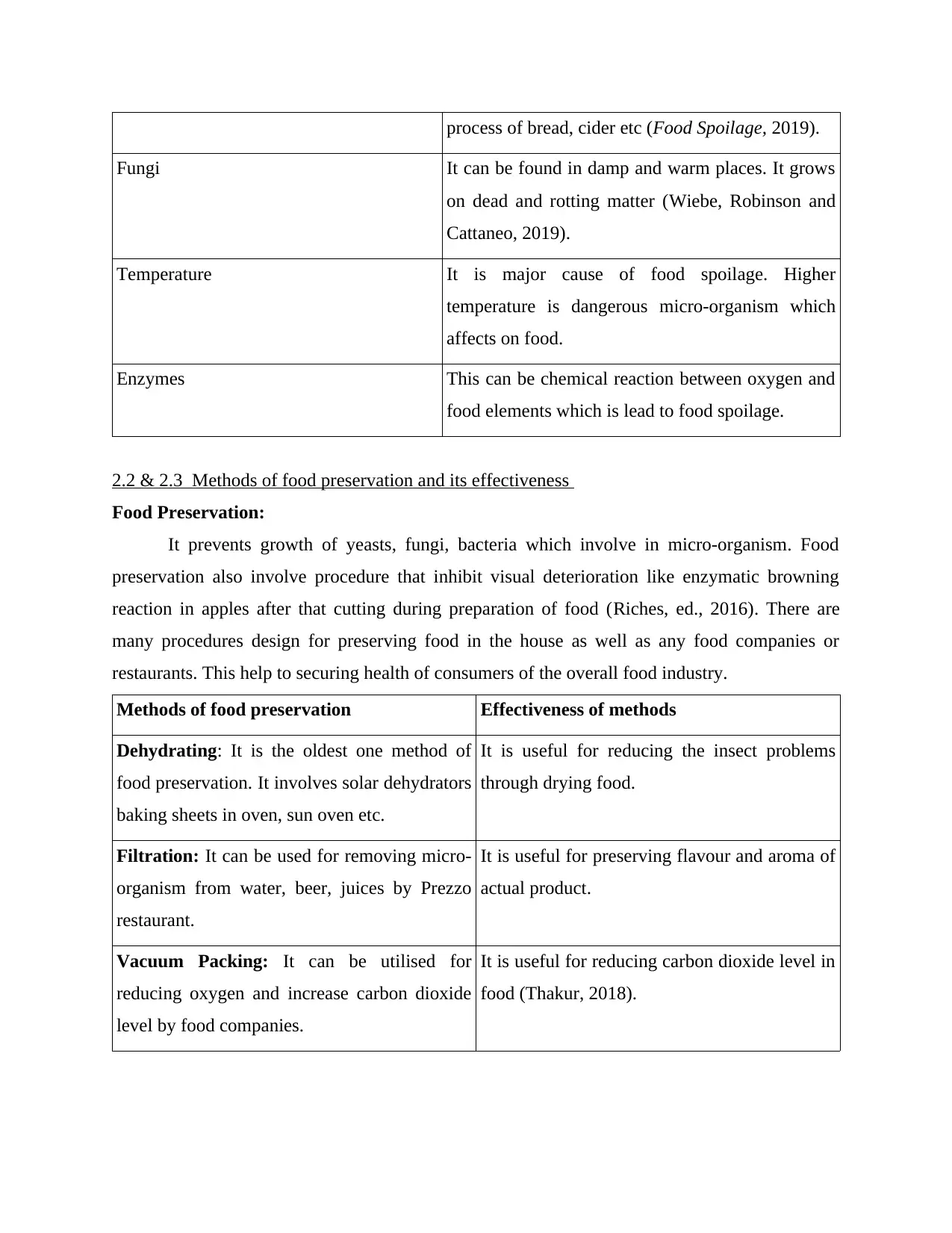
process of bread, cider etc (Food Spoilage, 2019).
Fungi It can be found in damp and warm places. It grows
on dead and rotting matter (Wiebe, Robinson and
Cattaneo, 2019).
Temperature It is major cause of food spoilage. Higher
temperature is dangerous micro-organism which
affects on food.
Enzymes This can be chemical reaction between oxygen and
food elements which is lead to food spoilage.
2.2 & 2.3 Methods of food preservation and its effectiveness
Food Preservation:
It prevents growth of yeasts, fungi, bacteria which involve in micro-organism. Food
preservation also involve procedure that inhibit visual deterioration like enzymatic browning
reaction in apples after that cutting during preparation of food (Riches, ed., 2016). There are
many procedures design for preserving food in the house as well as any food companies or
restaurants. This help to securing health of consumers of the overall food industry.
Methods of food preservation Effectiveness of methods
Dehydrating: It is the oldest one method of
food preservation. It involves solar dehydrators
baking sheets in oven, sun oven etc.
It is useful for reducing the insect problems
through drying food.
Filtration: It can be used for removing micro-
organism from water, beer, juices by Prezzo
restaurant.
It is useful for preserving flavour and aroma of
actual product.
Vacuum Packing: It can be utilised for
reducing oxygen and increase carbon dioxide
level by food companies.
It is useful for reducing carbon dioxide level in
food (Thakur, 2018).
Fungi It can be found in damp and warm places. It grows
on dead and rotting matter (Wiebe, Robinson and
Cattaneo, 2019).
Temperature It is major cause of food spoilage. Higher
temperature is dangerous micro-organism which
affects on food.
Enzymes This can be chemical reaction between oxygen and
food elements which is lead to food spoilage.
2.2 & 2.3 Methods of food preservation and its effectiveness
Food Preservation:
It prevents growth of yeasts, fungi, bacteria which involve in micro-organism. Food
preservation also involve procedure that inhibit visual deterioration like enzymatic browning
reaction in apples after that cutting during preparation of food (Riches, ed., 2016). There are
many procedures design for preserving food in the house as well as any food companies or
restaurants. This help to securing health of consumers of the overall food industry.
Methods of food preservation Effectiveness of methods
Dehydrating: It is the oldest one method of
food preservation. It involves solar dehydrators
baking sheets in oven, sun oven etc.
It is useful for reducing the insect problems
through drying food.
Filtration: It can be used for removing micro-
organism from water, beer, juices by Prezzo
restaurant.
It is useful for preserving flavour and aroma of
actual product.
Vacuum Packing: It can be utilised for
reducing oxygen and increase carbon dioxide
level by food companies.
It is useful for reducing carbon dioxide level in
food (Thakur, 2018).
Paraphrase This Document
Need a fresh take? Get an instant paraphrase of this document with our AI Paraphraser

Canning: It is the most distributed which
effective means of long term food storage.
Canning is useful to attain temperature high
enough to destroy chemicals.
Refrigeration: The temperature slows
microbial growth but it can not remove
microbes completely.
It is only utilized to preserve food for short
periods and use for household purpose.
Pasteurisation: It is method to preserve
heating food to temperature and reduce level of
organisms spoilage.
It can be utilised to kills micro-organism which
is causing diseases and decrease level of
spoilage organisms with minimum effect on
value and texture of food.
Irradiation: It is also called as exposure to
ionising radiation for sterilises various types
of food for storage of long term.
This method use for reducing the hazards of
irradiation which effect on food chemistry
during process of human involvement
(Sonnino, 2016).
TASK 3
3.1 Temperature control system
Temperature control system is essential for food safety, because food is required to time
and temperature control. There are many steps such as reheating, storage, cooling, preparation,
cooking etc.
Reheating:
It is step of control temperature for food safety. The internal temperature of food must
reach 165 F within two hours when food is reheating. It takes to ensure that temperature to
reached 165 F food for 15 seconds. The food held at 135 f or warmer once minimum temperature
has reached (Solomon, 2016).
Cooling:
It is another step of control temperature which is required for food safety. First, bring
food down from 135 F to 70 F within two hours. The best way to cool foods rapidly involve
utilising an ice bath, transferring food to shallow pan and dividing dense foods into smaller part.
It is to ensure that properly records the temperature during the cooling process on temperature
log, so that it cools appropriately.
effective means of long term food storage.
Canning is useful to attain temperature high
enough to destroy chemicals.
Refrigeration: The temperature slows
microbial growth but it can not remove
microbes completely.
It is only utilized to preserve food for short
periods and use for household purpose.
Pasteurisation: It is method to preserve
heating food to temperature and reduce level of
organisms spoilage.
It can be utilised to kills micro-organism which
is causing diseases and decrease level of
spoilage organisms with minimum effect on
value and texture of food.
Irradiation: It is also called as exposure to
ionising radiation for sterilises various types
of food for storage of long term.
This method use for reducing the hazards of
irradiation which effect on food chemistry
during process of human involvement
(Sonnino, 2016).
TASK 3
3.1 Temperature control system
Temperature control system is essential for food safety, because food is required to time
and temperature control. There are many steps such as reheating, storage, cooling, preparation,
cooking etc.
Reheating:
It is step of control temperature for food safety. The internal temperature of food must
reach 165 F within two hours when food is reheating. It takes to ensure that temperature to
reached 165 F food for 15 seconds. The food held at 135 f or warmer once minimum temperature
has reached (Solomon, 2016).
Cooling:
It is another step of control temperature which is required for food safety. First, bring
food down from 135 F to 70 F within two hours. The best way to cool foods rapidly involve
utilising an ice bath, transferring food to shallow pan and dividing dense foods into smaller part.
It is to ensure that properly records the temperature during the cooling process on temperature
log, so that it cools appropriately.
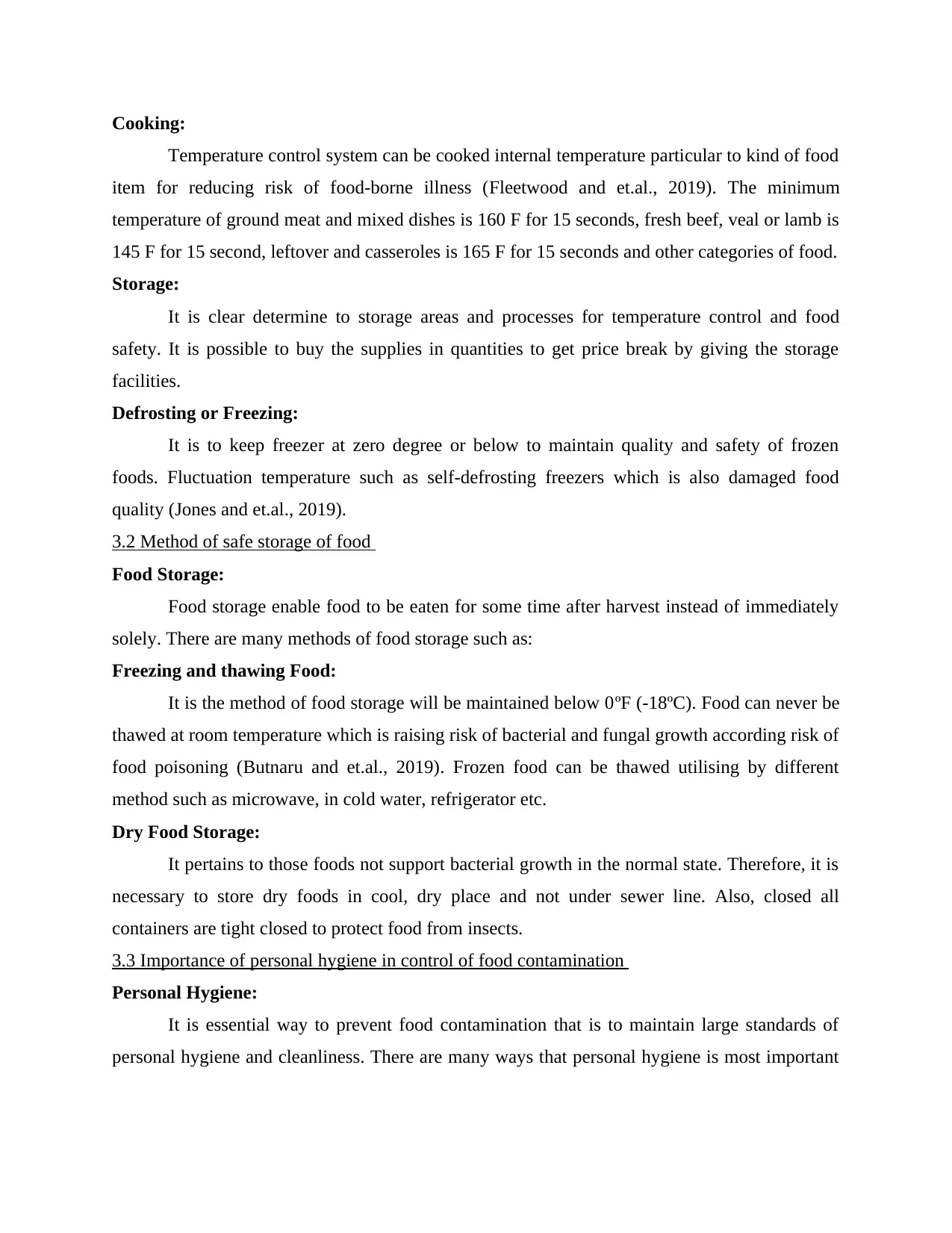
Cooking:
Temperature control system can be cooked internal temperature particular to kind of food
item for reducing risk of food-borne illness (Fleetwood and et.al., 2019). The minimum
temperature of ground meat and mixed dishes is 160 F for 15 seconds, fresh beef, veal or lamb is
145 F for 15 second, leftover and casseroles is 165 F for 15 seconds and other categories of food.
Storage:
It is clear determine to storage areas and processes for temperature control and food
safety. It is possible to buy the supplies in quantities to get price break by giving the storage
facilities.
Defrosting or Freezing:
It is to keep freezer at zero degree or below to maintain quality and safety of frozen
foods. Fluctuation temperature such as self-defrosting freezers which is also damaged food
quality (Jones and et.al., 2019).
3.2 Method of safe storage of food
Food Storage:
Food storage enable food to be eaten for some time after harvest instead of immediately
solely. There are many methods of food storage such as:
Freezing and thawing Food:
It is the method of food storage will be maintained below 0ºF (-18ºC). Food can never be
thawed at room temperature which is raising risk of bacterial and fungal growth according risk of
food poisoning (Butnaru and et.al., 2019). Frozen food can be thawed utilising by different
method such as microwave, in cold water, refrigerator etc.
Dry Food Storage:
It pertains to those foods not support bacterial growth in the normal state. Therefore, it is
necessary to store dry foods in cool, dry place and not under sewer line. Also, closed all
containers are tight closed to protect food from insects.
3.3 Importance of personal hygiene in control of food contamination
Personal Hygiene:
It is essential way to prevent food contamination that is to maintain large standards of
personal hygiene and cleanliness. There are many ways that personal hygiene is most important
Temperature control system can be cooked internal temperature particular to kind of food
item for reducing risk of food-borne illness (Fleetwood and et.al., 2019). The minimum
temperature of ground meat and mixed dishes is 160 F for 15 seconds, fresh beef, veal or lamb is
145 F for 15 second, leftover and casseroles is 165 F for 15 seconds and other categories of food.
Storage:
It is clear determine to storage areas and processes for temperature control and food
safety. It is possible to buy the supplies in quantities to get price break by giving the storage
facilities.
Defrosting or Freezing:
It is to keep freezer at zero degree or below to maintain quality and safety of frozen
foods. Fluctuation temperature such as self-defrosting freezers which is also damaged food
quality (Jones and et.al., 2019).
3.2 Method of safe storage of food
Food Storage:
Food storage enable food to be eaten for some time after harvest instead of immediately
solely. There are many methods of food storage such as:
Freezing and thawing Food:
It is the method of food storage will be maintained below 0ºF (-18ºC). Food can never be
thawed at room temperature which is raising risk of bacterial and fungal growth according risk of
food poisoning (Butnaru and et.al., 2019). Frozen food can be thawed utilising by different
method such as microwave, in cold water, refrigerator etc.
Dry Food Storage:
It pertains to those foods not support bacterial growth in the normal state. Therefore, it is
necessary to store dry foods in cool, dry place and not under sewer line. Also, closed all
containers are tight closed to protect food from insects.
3.3 Importance of personal hygiene in control of food contamination
Personal Hygiene:
It is essential way to prevent food contamination that is to maintain large standards of
personal hygiene and cleanliness. There are many ways that personal hygiene is most important
⊘ This is a preview!⊘
Do you want full access?
Subscribe today to unlock all pages.

Trusted by 1+ million students worldwide
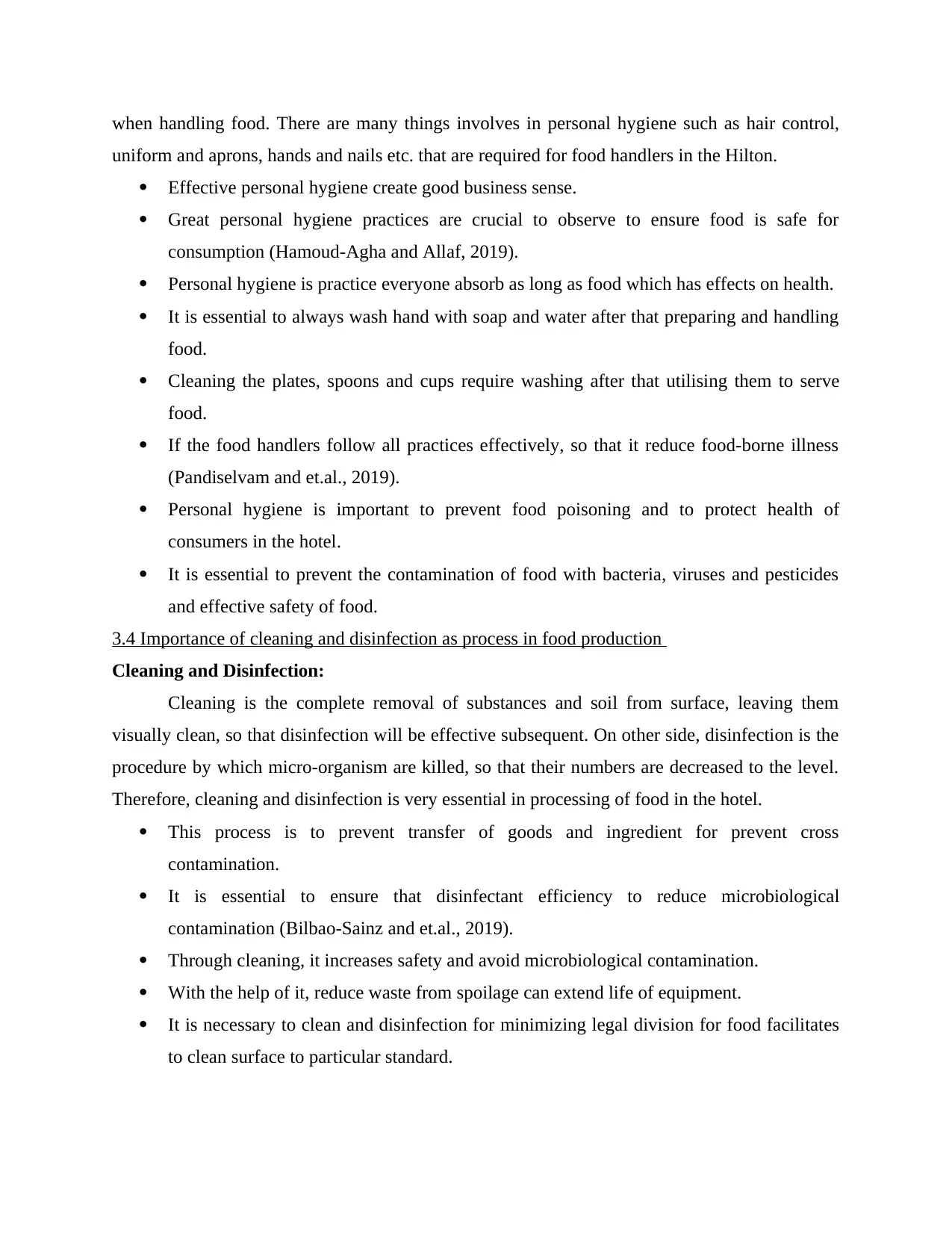
when handling food. There are many things involves in personal hygiene such as hair control,
uniform and aprons, hands and nails etc. that are required for food handlers in the Hilton.
Effective personal hygiene create good business sense.
Great personal hygiene practices are crucial to observe to ensure food is safe for
consumption (Hamoud-Agha and Allaf, 2019).
Personal hygiene is practice everyone absorb as long as food which has effects on health.
It is essential to always wash hand with soap and water after that preparing and handling
food.
Cleaning the plates, spoons and cups require washing after that utilising them to serve
food.
If the food handlers follow all practices effectively, so that it reduce food-borne illness
(Pandiselvam and et.al., 2019).
Personal hygiene is important to prevent food poisoning and to protect health of
consumers in the hotel.
It is essential to prevent the contamination of food with bacteria, viruses and pesticides
and effective safety of food.
3.4 Importance of cleaning and disinfection as process in food production
Cleaning and Disinfection:
Cleaning is the complete removal of substances and soil from surface, leaving them
visually clean, so that disinfection will be effective subsequent. On other side, disinfection is the
procedure by which micro-organism are killed, so that their numbers are decreased to the level.
Therefore, cleaning and disinfection is very essential in processing of food in the hotel.
This process is to prevent transfer of goods and ingredient for prevent cross
contamination.
It is essential to ensure that disinfectant efficiency to reduce microbiological
contamination (Bilbao-Sainz and et.al., 2019).
Through cleaning, it increases safety and avoid microbiological contamination.
With the help of it, reduce waste from spoilage can extend life of equipment.
It is necessary to clean and disinfection for minimizing legal division for food facilitates
to clean surface to particular standard.
uniform and aprons, hands and nails etc. that are required for food handlers in the Hilton.
Effective personal hygiene create good business sense.
Great personal hygiene practices are crucial to observe to ensure food is safe for
consumption (Hamoud-Agha and Allaf, 2019).
Personal hygiene is practice everyone absorb as long as food which has effects on health.
It is essential to always wash hand with soap and water after that preparing and handling
food.
Cleaning the plates, spoons and cups require washing after that utilising them to serve
food.
If the food handlers follow all practices effectively, so that it reduce food-borne illness
(Pandiselvam and et.al., 2019).
Personal hygiene is important to prevent food poisoning and to protect health of
consumers in the hotel.
It is essential to prevent the contamination of food with bacteria, viruses and pesticides
and effective safety of food.
3.4 Importance of cleaning and disinfection as process in food production
Cleaning and Disinfection:
Cleaning is the complete removal of substances and soil from surface, leaving them
visually clean, so that disinfection will be effective subsequent. On other side, disinfection is the
procedure by which micro-organism are killed, so that their numbers are decreased to the level.
Therefore, cleaning and disinfection is very essential in processing of food in the hotel.
This process is to prevent transfer of goods and ingredient for prevent cross
contamination.
It is essential to ensure that disinfectant efficiency to reduce microbiological
contamination (Bilbao-Sainz and et.al., 2019).
Through cleaning, it increases safety and avoid microbiological contamination.
With the help of it, reduce waste from spoilage can extend life of equipment.
It is necessary to clean and disinfection for minimizing legal division for food facilitates
to clean surface to particular standard.
Paraphrase This Document
Need a fresh take? Get an instant paraphrase of this document with our AI Paraphraser

3.5 Problems associated with pest control in food premises
Food manager of Hilton is required to check to number of health codes, but pest control
is between the most essential and challenging for manager in relation to food safety. Rodents,
insects, birds are common pests in food (Chemat and et.al., 2017). It is necessary to take steps to
prevent problems of pest. Also, it is essential to gain access to the food premises. There are many
problems associated with pest control in food premises such as:
Pests move food poisoning bacteria in their dropping , fur, feathers and feet.
Rats and mice masticate on woodwork gas pipes cables etc. to wear down their incisor
teeth.
Cockroaches also move variety of bacteria and easily contaminate food with faeces and
dead bodies.
It leaves unpleasant smell, warm and moist areas, so they find behind ovens and hot
water pipes (Konieczka and Namiesnik, 2016)
Birds do not carry pathogens, but they can move salmonella and campylobacter. They
have located useful food sources.
Insects like files and wasps which are moved bacteria and contaminate food by
transferring from their legs and body.
3.6 Need of hygiene design and construction of food premises
Hygiene design and construction of food premises are very necessary to reduce risk of
food contamination. There are various ways for designing and constructing food premises that
are essential for food industry (Alli, 2016). Hygiene design and construction involves pest
control, staff welfare facilities, personal hygiene facilities cleaning of windows, reduce
temperature etc. Such as:
Hygiene design is necessary to prevent the contamination of foods.
It is needed to securing the health of consumer in the hotel.
All the hygiene designing help to reduce the risk of cross contamination.
With the help of it, food manager ensure that safely and effectively processing of food in
the workplace (Gu and et.al., 2019).
Hygiene design is necessary to storages and preserving food effectively in the store.
Hygiene construction help to reduce entry of various pests, insects etc. in the production
areas.
Food manager of Hilton is required to check to number of health codes, but pest control
is between the most essential and challenging for manager in relation to food safety. Rodents,
insects, birds are common pests in food (Chemat and et.al., 2017). It is necessary to take steps to
prevent problems of pest. Also, it is essential to gain access to the food premises. There are many
problems associated with pest control in food premises such as:
Pests move food poisoning bacteria in their dropping , fur, feathers and feet.
Rats and mice masticate on woodwork gas pipes cables etc. to wear down their incisor
teeth.
Cockroaches also move variety of bacteria and easily contaminate food with faeces and
dead bodies.
It leaves unpleasant smell, warm and moist areas, so they find behind ovens and hot
water pipes (Konieczka and Namiesnik, 2016)
Birds do not carry pathogens, but they can move salmonella and campylobacter. They
have located useful food sources.
Insects like files and wasps which are moved bacteria and contaminate food by
transferring from their legs and body.
3.6 Need of hygiene design and construction of food premises
Hygiene design and construction of food premises are very necessary to reduce risk of
food contamination. There are various ways for designing and constructing food premises that
are essential for food industry (Alli, 2016). Hygiene design and construction involves pest
control, staff welfare facilities, personal hygiene facilities cleaning of windows, reduce
temperature etc. Such as:
Hygiene design is necessary to prevent the contamination of foods.
It is needed to securing the health of consumer in the hotel.
All the hygiene designing help to reduce the risk of cross contamination.
With the help of it, food manager ensure that safely and effectively processing of food in
the workplace (Gu and et.al., 2019).
Hygiene design is necessary to storages and preserving food effectively in the store.
Hygiene construction help to reduce entry of various pests, insects etc. in the production
areas.
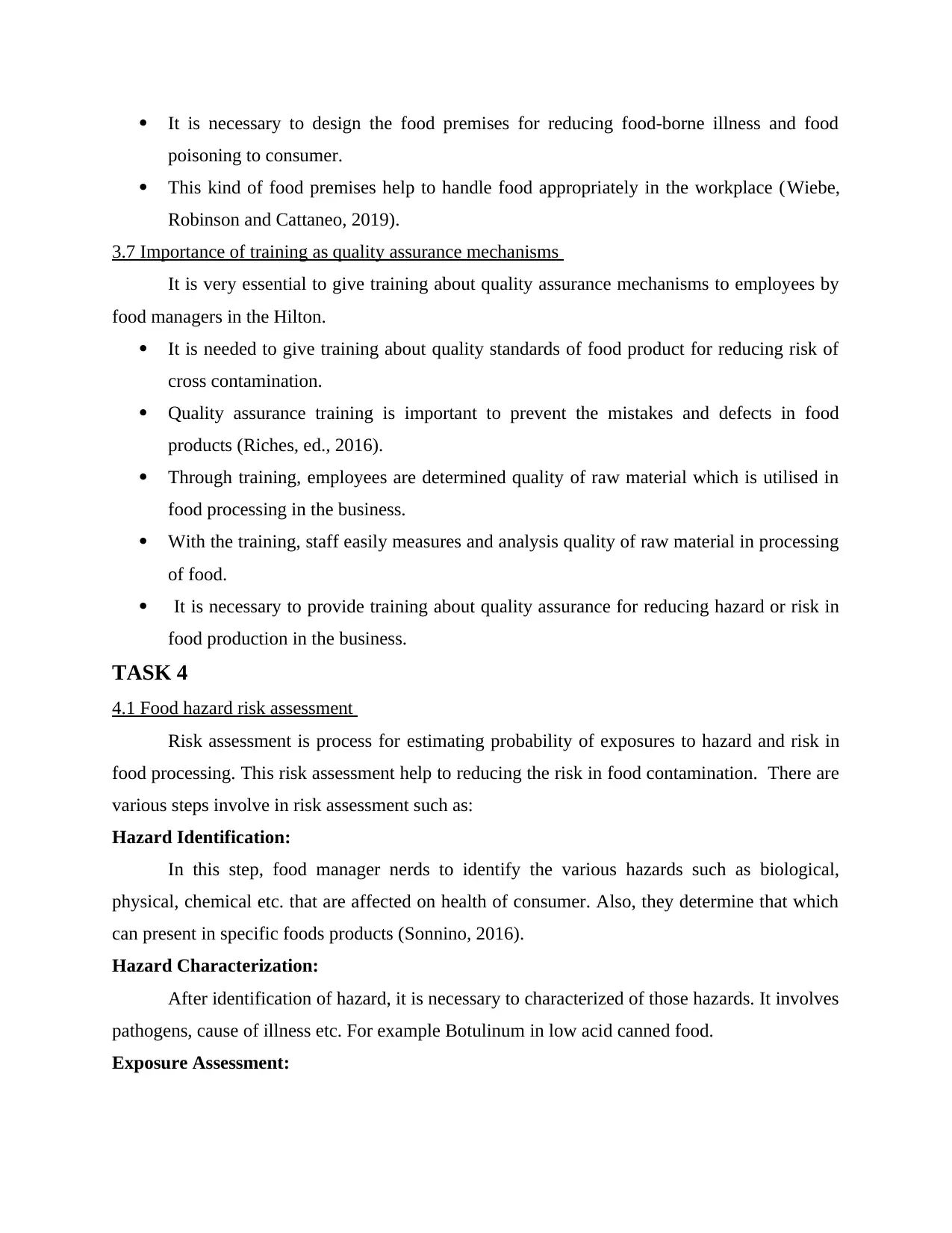
It is necessary to design the food premises for reducing food-borne illness and food
poisoning to consumer.
This kind of food premises help to handle food appropriately in the workplace (Wiebe,
Robinson and Cattaneo, 2019).
3.7 Importance of training as quality assurance mechanisms
It is very essential to give training about quality assurance mechanisms to employees by
food managers in the Hilton.
It is needed to give training about quality standards of food product for reducing risk of
cross contamination.
Quality assurance training is important to prevent the mistakes and defects in food
products (Riches, ed., 2016).
Through training, employees are determined quality of raw material which is utilised in
food processing in the business.
With the training, staff easily measures and analysis quality of raw material in processing
of food.
It is necessary to provide training about quality assurance for reducing hazard or risk in
food production in the business.
TASK 4
4.1 Food hazard risk assessment
Risk assessment is process for estimating probability of exposures to hazard and risk in
food processing. This risk assessment help to reducing the risk in food contamination. There are
various steps involve in risk assessment such as:
Hazard Identification:
In this step, food manager nerds to identify the various hazards such as biological,
physical, chemical etc. that are affected on health of consumer. Also, they determine that which
can present in specific foods products (Sonnino, 2016).
Hazard Characterization:
After identification of hazard, it is necessary to characterized of those hazards. It involves
pathogens, cause of illness etc. For example Botulinum in low acid canned food.
Exposure Assessment:
poisoning to consumer.
This kind of food premises help to handle food appropriately in the workplace (Wiebe,
Robinson and Cattaneo, 2019).
3.7 Importance of training as quality assurance mechanisms
It is very essential to give training about quality assurance mechanisms to employees by
food managers in the Hilton.
It is needed to give training about quality standards of food product for reducing risk of
cross contamination.
Quality assurance training is important to prevent the mistakes and defects in food
products (Riches, ed., 2016).
Through training, employees are determined quality of raw material which is utilised in
food processing in the business.
With the training, staff easily measures and analysis quality of raw material in processing
of food.
It is necessary to provide training about quality assurance for reducing hazard or risk in
food production in the business.
TASK 4
4.1 Food hazard risk assessment
Risk assessment is process for estimating probability of exposures to hazard and risk in
food processing. This risk assessment help to reducing the risk in food contamination. There are
various steps involve in risk assessment such as:
Hazard Identification:
In this step, food manager nerds to identify the various hazards such as biological,
physical, chemical etc. that are affected on health of consumer. Also, they determine that which
can present in specific foods products (Sonnino, 2016).
Hazard Characterization:
After identification of hazard, it is necessary to characterized of those hazards. It involves
pathogens, cause of illness etc. For example Botulinum in low acid canned food.
Exposure Assessment:
⊘ This is a preview!⊘
Do you want full access?
Subscribe today to unlock all pages.

Trusted by 1+ million students worldwide
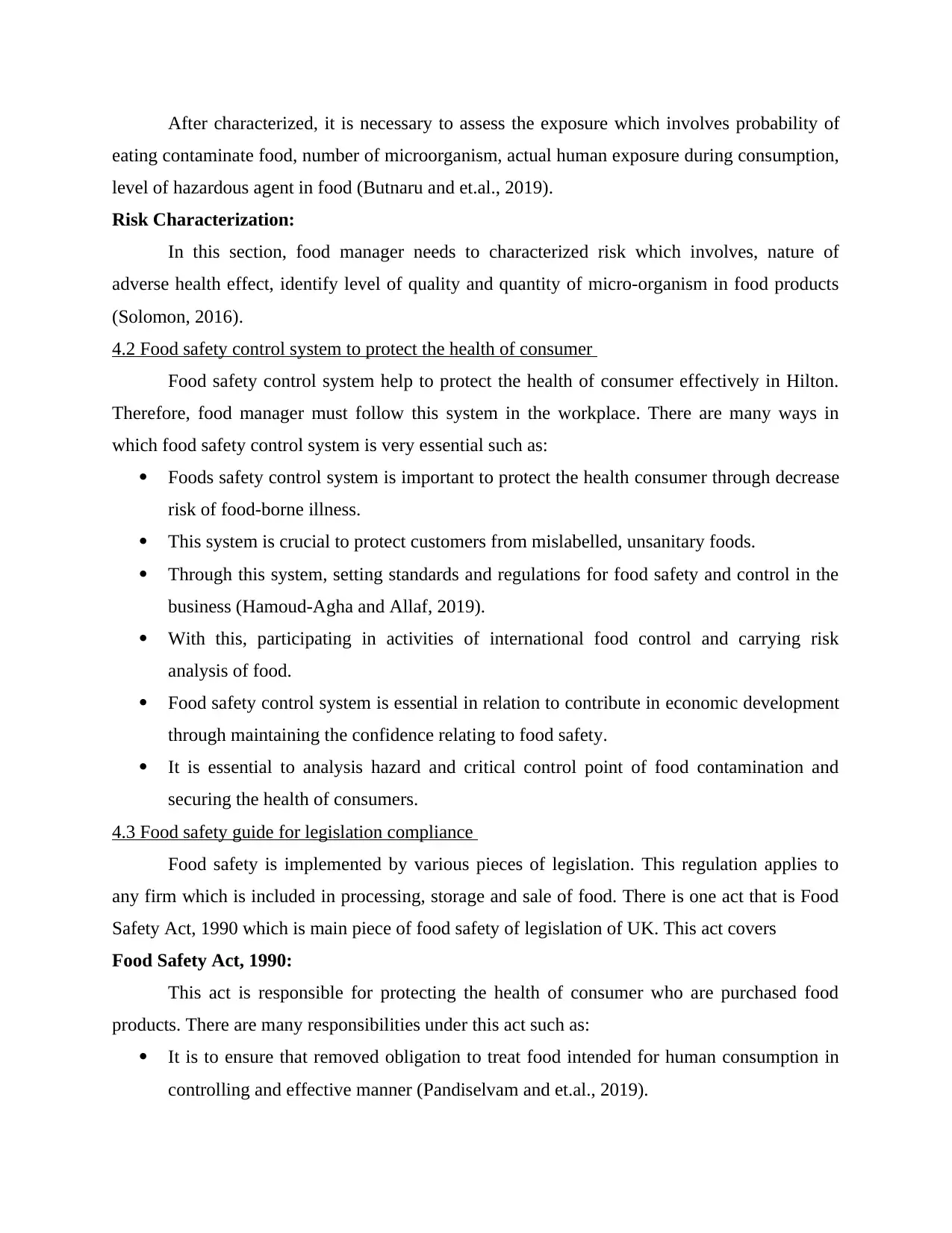
After characterized, it is necessary to assess the exposure which involves probability of
eating contaminate food, number of microorganism, actual human exposure during consumption,
level of hazardous agent in food (Butnaru and et.al., 2019).
Risk Characterization:
In this section, food manager needs to characterized risk which involves, nature of
adverse health effect, identify level of quality and quantity of micro-organism in food products
(Solomon, 2016).
4.2 Food safety control system to protect the health of consumer
Food safety control system help to protect the health of consumer effectively in Hilton.
Therefore, food manager must follow this system in the workplace. There are many ways in
which food safety control system is very essential such as:
Foods safety control system is important to protect the health consumer through decrease
risk of food-borne illness.
This system is crucial to protect customers from mislabelled, unsanitary foods.
Through this system, setting standards and regulations for food safety and control in the
business (Hamoud-Agha and Allaf, 2019).
With this, participating in activities of international food control and carrying risk
analysis of food.
Food safety control system is essential in relation to contribute in economic development
through maintaining the confidence relating to food safety.
It is essential to analysis hazard and critical control point of food contamination and
securing the health of consumers.
4.3 Food safety guide for legislation compliance
Food safety is implemented by various pieces of legislation. This regulation applies to
any firm which is included in processing, storage and sale of food. There is one act that is Food
Safety Act, 1990 which is main piece of food safety of legislation of UK. This act covers
Food Safety Act, 1990:
This act is responsible for protecting the health of consumer who are purchased food
products. There are many responsibilities under this act such as:
It is to ensure that removed obligation to treat food intended for human consumption in
controlling and effective manner (Pandiselvam and et.al., 2019).
eating contaminate food, number of microorganism, actual human exposure during consumption,
level of hazardous agent in food (Butnaru and et.al., 2019).
Risk Characterization:
In this section, food manager needs to characterized risk which involves, nature of
adverse health effect, identify level of quality and quantity of micro-organism in food products
(Solomon, 2016).
4.2 Food safety control system to protect the health of consumer
Food safety control system help to protect the health of consumer effectively in Hilton.
Therefore, food manager must follow this system in the workplace. There are many ways in
which food safety control system is very essential such as:
Foods safety control system is important to protect the health consumer through decrease
risk of food-borne illness.
This system is crucial to protect customers from mislabelled, unsanitary foods.
Through this system, setting standards and regulations for food safety and control in the
business (Hamoud-Agha and Allaf, 2019).
With this, participating in activities of international food control and carrying risk
analysis of food.
Food safety control system is essential in relation to contribute in economic development
through maintaining the confidence relating to food safety.
It is essential to analysis hazard and critical control point of food contamination and
securing the health of consumers.
4.3 Food safety guide for legislation compliance
Food safety is implemented by various pieces of legislation. This regulation applies to
any firm which is included in processing, storage and sale of food. There is one act that is Food
Safety Act, 1990 which is main piece of food safety of legislation of UK. This act covers
Food Safety Act, 1990:
This act is responsible for protecting the health of consumer who are purchased food
products. There are many responsibilities under this act such as:
It is to ensure that removed obligation to treat food intended for human consumption in
controlling and effective manner (Pandiselvam and et.al., 2019).
Paraphrase This Document
Need a fresh take? Get an instant paraphrase of this document with our AI Paraphraser
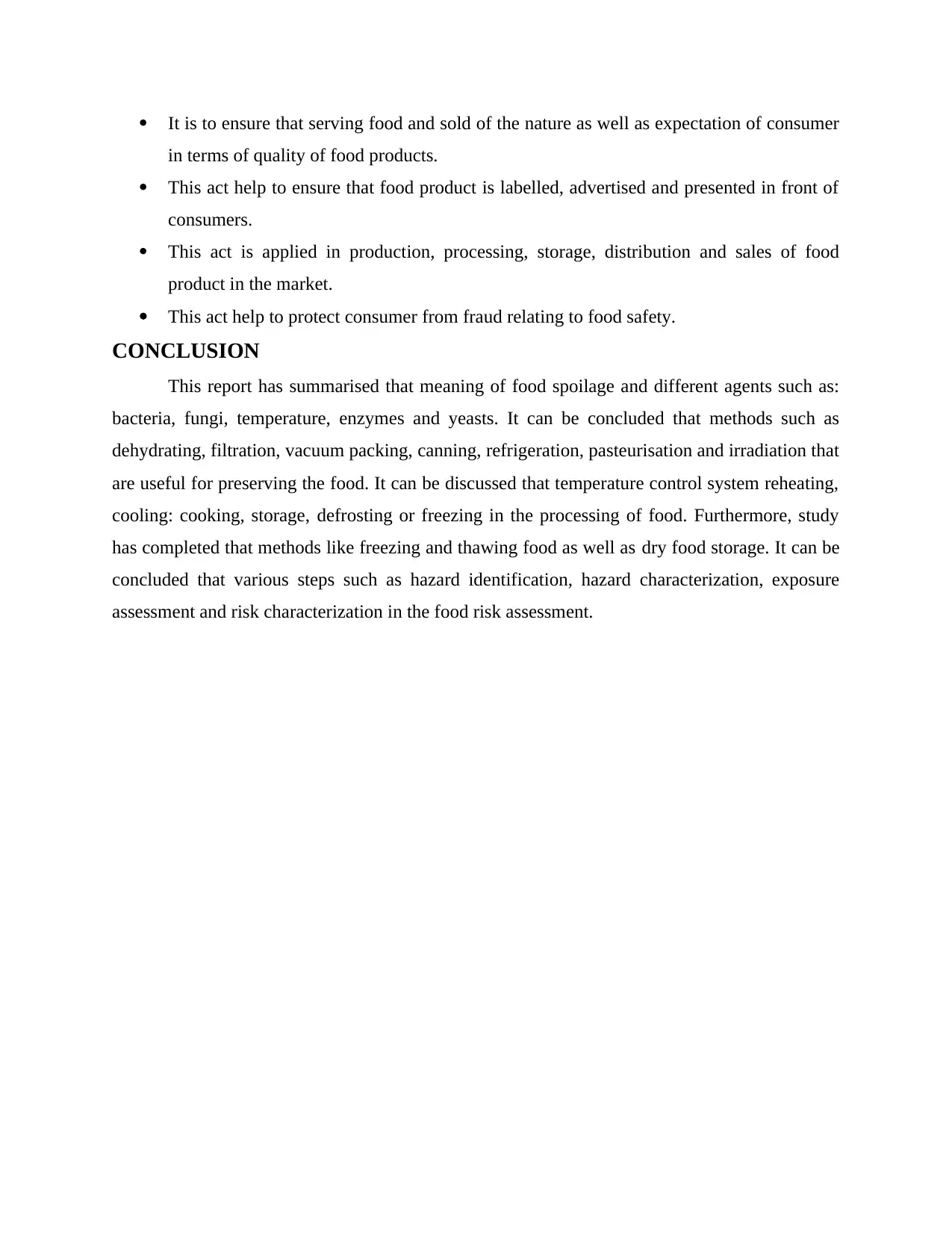
It is to ensure that serving food and sold of the nature as well as expectation of consumer
in terms of quality of food products.
This act help to ensure that food product is labelled, advertised and presented in front of
consumers.
This act is applied in production, processing, storage, distribution and sales of food
product in the market.
This act help to protect consumer from fraud relating to food safety.
CONCLUSION
This report has summarised that meaning of food spoilage and different agents such as:
bacteria, fungi, temperature, enzymes and yeasts. It can be concluded that methods such as
dehydrating, filtration, vacuum packing, canning, refrigeration, pasteurisation and irradiation that
are useful for preserving the food. It can be discussed that temperature control system reheating,
cooling: cooking, storage, defrosting or freezing in the processing of food. Furthermore, study
has completed that methods like freezing and thawing food as well as dry food storage. It can be
concluded that various steps such as hazard identification, hazard characterization, exposure
assessment and risk characterization in the food risk assessment.
in terms of quality of food products.
This act help to ensure that food product is labelled, advertised and presented in front of
consumers.
This act is applied in production, processing, storage, distribution and sales of food
product in the market.
This act help to protect consumer from fraud relating to food safety.
CONCLUSION
This report has summarised that meaning of food spoilage and different agents such as:
bacteria, fungi, temperature, enzymes and yeasts. It can be concluded that methods such as
dehydrating, filtration, vacuum packing, canning, refrigeration, pasteurisation and irradiation that
are useful for preserving the food. It can be discussed that temperature control system reheating,
cooling: cooking, storage, defrosting or freezing in the processing of food. Furthermore, study
has completed that methods like freezing and thawing food as well as dry food storage. It can be
concluded that various steps such as hazard identification, hazard characterization, exposure
assessment and risk characterization in the food risk assessment.
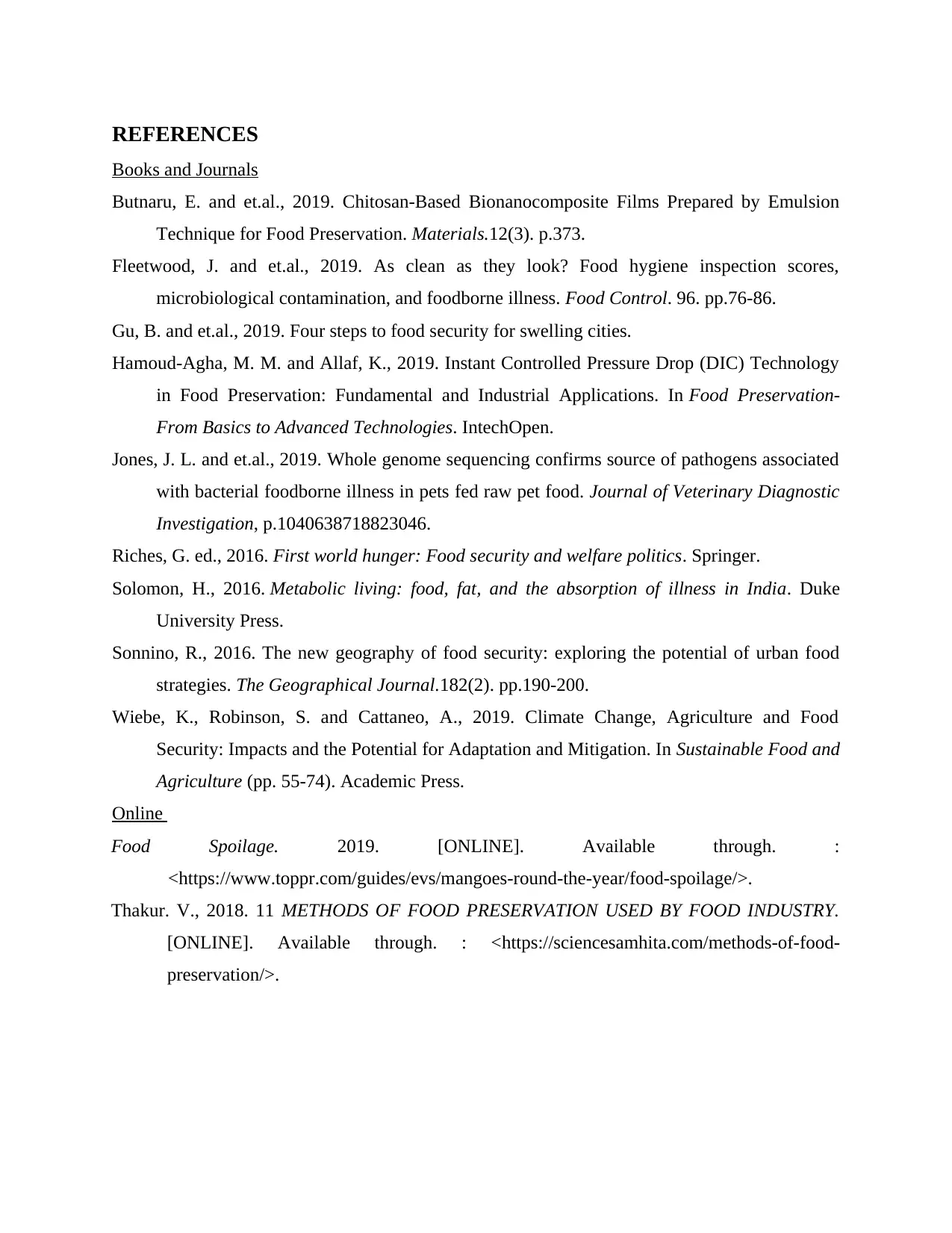
REFERENCES
Books and Journals
Butnaru, E. and et.al., 2019. Chitosan-Based Bionanocomposite Films Prepared by Emulsion
Technique for Food Preservation. Materials.12(3). p.373.
Fleetwood, J. and et.al., 2019. As clean as they look? Food hygiene inspection scores,
microbiological contamination, and foodborne illness. Food Control. 96. pp.76-86.
Gu, B. and et.al., 2019. Four steps to food security for swelling cities.
Hamoud-Agha, M. M. and Allaf, K., 2019. Instant Controlled Pressure Drop (DIC) Technology
in Food Preservation: Fundamental and Industrial Applications. In Food Preservation-
From Basics to Advanced Technologies. IntechOpen.
Jones, J. L. and et.al., 2019. Whole genome sequencing confirms source of pathogens associated
with bacterial foodborne illness in pets fed raw pet food. Journal of Veterinary Diagnostic
Investigation, p.1040638718823046.
Riches, G. ed., 2016. First world hunger: Food security and welfare politics. Springer.
Solomon, H., 2016. Metabolic living: food, fat, and the absorption of illness in India. Duke
University Press.
Sonnino, R., 2016. The new geography of food security: exploring the potential of urban food
strategies. The Geographical Journal.182(2). pp.190-200.
Wiebe, K., Robinson, S. and Cattaneo, A., 2019. Climate Change, Agriculture and Food
Security: Impacts and the Potential for Adaptation and Mitigation. In Sustainable Food and
Agriculture (pp. 55-74). Academic Press.
Online
Food Spoilage. 2019. [ONLINE]. Available through. :
<https://www.toppr.com/guides/evs/mangoes-round-the-year/food-spoilage/>.
Thakur. V., 2018. 11 METHODS OF FOOD PRESERVATION USED BY FOOD INDUSTRY.
[ONLINE]. Available through. : <https://sciencesamhita.com/methods-of-food-
preservation/>.
Books and Journals
Butnaru, E. and et.al., 2019. Chitosan-Based Bionanocomposite Films Prepared by Emulsion
Technique for Food Preservation. Materials.12(3). p.373.
Fleetwood, J. and et.al., 2019. As clean as they look? Food hygiene inspection scores,
microbiological contamination, and foodborne illness. Food Control. 96. pp.76-86.
Gu, B. and et.al., 2019. Four steps to food security for swelling cities.
Hamoud-Agha, M. M. and Allaf, K., 2019. Instant Controlled Pressure Drop (DIC) Technology
in Food Preservation: Fundamental and Industrial Applications. In Food Preservation-
From Basics to Advanced Technologies. IntechOpen.
Jones, J. L. and et.al., 2019. Whole genome sequencing confirms source of pathogens associated
with bacterial foodborne illness in pets fed raw pet food. Journal of Veterinary Diagnostic
Investigation, p.1040638718823046.
Riches, G. ed., 2016. First world hunger: Food security and welfare politics. Springer.
Solomon, H., 2016. Metabolic living: food, fat, and the absorption of illness in India. Duke
University Press.
Sonnino, R., 2016. The new geography of food security: exploring the potential of urban food
strategies. The Geographical Journal.182(2). pp.190-200.
Wiebe, K., Robinson, S. and Cattaneo, A., 2019. Climate Change, Agriculture and Food
Security: Impacts and the Potential for Adaptation and Mitigation. In Sustainable Food and
Agriculture (pp. 55-74). Academic Press.
Online
Food Spoilage. 2019. [ONLINE]. Available through. :
<https://www.toppr.com/guides/evs/mangoes-round-the-year/food-spoilage/>.
Thakur. V., 2018. 11 METHODS OF FOOD PRESERVATION USED BY FOOD INDUSTRY.
[ONLINE]. Available through. : <https://sciencesamhita.com/methods-of-food-
preservation/>.
⊘ This is a preview!⊘
Do you want full access?
Subscribe today to unlock all pages.

Trusted by 1+ million students worldwide
1 out of 12
Related Documents
Your All-in-One AI-Powered Toolkit for Academic Success.
+13062052269
info@desklib.com
Available 24*7 on WhatsApp / Email
![[object Object]](/_next/static/media/star-bottom.7253800d.svg)
Unlock your academic potential
Copyright © 2020–2025 A2Z Services. All Rights Reserved. Developed and managed by ZUCOL.





